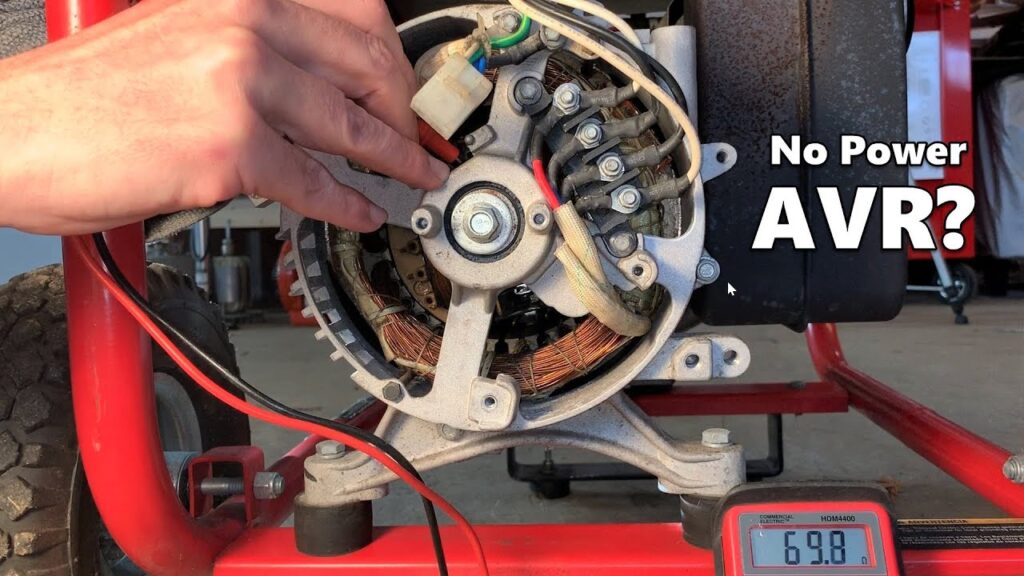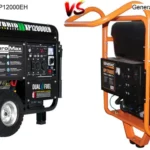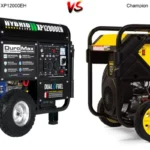If you’re the proud owner of a Honda generator and have run into a problem where the generator is running but no power is being generated, you’ve come to the right place. In this article, we’ll provide a step-by-step guide on how to troubleshoot your generator and get it up and running again. Let’s get started!
What is a Generator?

A generator is an electrical device that produces an alternating current (AC) of voltage. It is typically used to power electrical equipment and appliances when there is a power outage or in places where there is no access to a power grid. Generators can be powered by gasoline, diesel, natural gas, propane, or solar power.
Generators come in many sizes and types, from small portable units to large permanent systems. The most common type of generator is an internal combustion engine, which uses a fuel source to spin an alternator, which then produces electricity. Other types of generators include those powered by wind turbines and solar panels.
When a honda generator runs but no power is produced, it means that the generator is not functioning properly. This could be due to a variety of issues, including mechanical problems with the engine or alternator, or an issue with the fuel delivery system. It is recommended to have the generator checked by a qualified technician to ensure that it is working properly.
Understanding Different Types of Generators

Generators are a great way to provide power in areas where there is no electricity or when power outages occur. Generators come in a variety of sizes, types, and capabilities, so it is important to understand the differences between them.
1. Portable Generators
Portable generators are powered by gasoline and are generally the least expensive type of generator. They are ideal for camping trips, tailgating, and other outdoor activities. Portable generators are designed to be easily moved and can provide power for a variety of small appliances.
2. Inverter Generators
Inverter generators are powered by gasoline and are more expensive than portable generators. They are quieter, more fuel efficient, and can provide clean power for more delicate electronics. Inverter generators are commonly used for camping trips, tailgating, and other outdoor activities.
3. Standby Generators
Standby generators are powered by gasoline, diesel, or natural gas and are the most expensive type of generator. They are designed to provide power to an entire home or business in the event of a power outage. Standby generators are permanently installed and require regular maintenance.
Honda Generators

Honda Generators are the perfect choice for a reliable source of power. They are designed to be reliable, efficient and easy to use, making them ideal for a wide range of applications. Honda Generators are designed to be lightweight and portable, and they come in both petrol and diesel models.
When a Honda Generator runs but no power is produced, there are a few potential causes. The most common issue is a fuel system issue, such as a clogged air filter or a faulty fuel pump. Additionally, a dirty spark plug or a faulty spark plug wire can also cause the generator to run but not produce any power.
In some cases, the generator may not be getting enough fuel or air. This can be caused by an old, worn out fuel filter or a dirty air filter. Additionally, a faulty spark plug or spark plug wire can also prevent the generator from producing power.
If the generator is not producing any power, it is important to check the connection between the generator and the power source. If the connection is loose or damaged, the generator may not be able to draw the necessary power to run. Additionally, a defective battery or a faulty regulator can also prevent the generator from producing power.
In some cases, the generator may need to be serviced in order to restore its power. This could involve replacing the spark plugs, spark plug wires, fuel filter or air filter, or even replacing the entire engine. It is important to have a qualified technician service the generator in order to ensure that the generator is working properly and producing the necessary power.
Honda Generators are an excellent choice for a reliable source of power. They are designed to be efficient and easy to use, and they come in a variety of models so you can find the perfect fit for your needs. However, if your Honda Generator runs but no power is produced, it is important to diagnose the cause and have the generator serviced if necessary.
Troubleshooting Common Generator Problems

No Power Output
If your Honda generator isn’t producing any power at all, there are a few potential causes to consider. First, make sure the generator is receiving fuel. If you’ve recently filled the fuel tank, check the fuel filter and fuel line for any blockages or clogs. If the fuel line is clear and fuel is getting to the engine, the problem may be with the spark plug. Check the spark plug to ensure it is functioning properly. If it is not, then you may need to replace it.
Generator Not Putting Out Full Power
If your Honda generator isn’t producing full power output, there are a few potential causes to consider. First, check the air filter and make sure it’s not clogged or blocked. If the filter appears clean, then the problem may be with the spark plug. Check the spark plug to ensure it is functioning properly. If it is not, then you may need to replace it. Additionally, the generator may be running too rich or too lean. Check the fuel mixture and adjust it as needed.
3. Honda Generator Runs but No Power

If your Honda generator is running but not producing any power, there is likely an issue with either the engine or the electrical components. To determine the cause of the problem, it is important to check the engine and the electrical components separately.
Engine Check
| Step | Process |
|---|---|
| 1 | Check the oil level and add oil if necessary. |
| 2 | Check the air filter and replace if necessary. |
| 3 | Check the spark plug and replace if necessary. |
| 4 | Check the fuel filter and replace if necessary. |
| 5 | Check the fuel lines and replace if necessary. |
Electrical Check
| Step | Process |
|---|---|
| 1 | Check the circuit breaker and reset if necessary. |
| 2 | Check the starter switch and replace if necessary. |
| 3 | Check the voltage regulator and replace if necessary. |
| 4 | Check the AVR (automatic voltage regulator) and replace if necessary. |
| 5 | Check the wiring and replace any broken or corroded wires. |
If all of the engine and electrical components are functioning properly, the issue is likely with the generator itself. A qualified technician should be consulted to diagnose and repair the issue.
Safety Considerations

When troubleshooting a Honda generator that is running but not providing power, it is important to consider safety. First and foremost, make sure to disconnect the generator from any power source before beginning any repair work. Additionally, be sure to take proper safety precautions when inspecting or replacing components. Wear protective gear such as gloves and safety glasses, and keep your hands away from any moving parts. Furthermore, be aware of any potential hazards such as sharp edges or exposed wiring. Finally, take the time to read and understand the owner’s manual before attempting to make any repairs. Following these safety considerations can help ensure a safe repair process.
Maintenance
A Honda generator is a reliable and sturdy piece of equipment, but like all machines, it requires regular maintenance to ensure it continues to work as intended. Here are some common maintenance tasks that should be done on a regular basis to keep a Honda generator running properly:
- Check the air filter and replace if necessary.
- Change the oil and oil filter regularly.
- Check the spark plugs and replace if necessary.
- Check the fuel filter and replace if necessary.
- Check the fuel lines and replace if necessary.
- Check the exhaust system and replace if necessary.
- Check the electrical wiring and replace if necessary.
- Inspect the generator for any loose or worn parts and replace as needed.
By performing these regular maintenance tasks, you can help ensure that your Honda generator runs reliably and efficiently. If you find that your generator is not providing power, it may be time to perform some routine maintenance to get it running again.
Frequently Asked Questions
1. What could cause my Honda generator to run but not output power?
There are several possible causes for a Honda generator to run without producing any power. Some of these include:
- The generator’s engine could be running but the output voltage is not sufficient to power the intended device.
- The generator’s engine could be running but the circuit breaker has tripped.
- The generator’s engine could be running but the spark plug is not firing properly.
- The generator’s engine could be running but the fuel lines are blocked or clogged.
- The generator’s engine could be running but the air filter is dirty or clogged.
- The generator’s engine could be running but the fuel is old and has not been changed in a long time.
If none of these causes are present, it is possible that the generator’s engine is not running properly. If this is the case, the engine should be serviced by a qualified technician.
2. What should I do if my Honda generator isn’t putting out full power?
- Check the fuel supply to ensure that the generator is getting enough fuel.
- Check the fuel filter to make sure it is clean and not blocked.
- Check the spark plugs to make sure they are clean and not fouled.
- Check the air filter to make sure it is clean and not blocked.
- Check the engine oil level to make sure it is full.
- Check the battery voltage to make sure it is not low.
- Check the generator controls to make sure they are all set correctly.
- Check the generator exhaust to make sure it is not blocked.
- Check the generator for any loose or damaged wiring.
- If the generator is still not putting out full power, it may need to be serviced by a qualified technician.
3. How can I troubleshoot an inverter generator that isn’t producing any power?
If your Honda generator is running, but not producing any power, there are a few steps you can take to troubleshoot the issue. Here are the steps you should take:
- Check to make sure the generator is switched to the “On” position.
- Check the fuel tank and make sure there is enough fuel for the generator to run.
- Check the oil level and make sure it is at the correct level.
- Check the spark plug to make sure it is in good condition and not dirty or damaged.
- Check the air filter to make sure it is clean and not clogged.
- Check the generator’s electrical connections to make sure they are secure and connected properly.
- Check the circuit breaker and make sure it is not tripped.
- Check the output voltage to make sure it is within the correct range.
If you have completed all of these steps and the generator is still not producing any power, you may need to contact a professional for further assistance.
4. Is there a way to determine why my Honda generator is running but not outputting power?
There are several common reasons why a Honda generator might be running but not outputting power. To diagnose the issue, it is best to start with the most common causes and work through them one at a time.
- The generator could be low on oil or fuel. This is often the first thing to check when a generator is running but not producing power.
- The spark plug gap could be incorrect. This is a very common issue and can be easily checked using a spark plug gap tester.
- The air filter could be clogged or dirty. This is another common problem and can be easily checked and cleaned or replaced.
- The generator could have a bad or loose connection. This can be checked by inspecting the wiring and connections and ensuring they are all secure and in good condition.
- The generator could have a faulty ignition system or starter. This is usually a more serious problem and can require professional service.
If none of these solutions work, then it is recommended to contact a professional for further diagnosis and repair.
5. What are some possible reasons why my Honda generator is running but not producing power?
- The generator is not receiving enough fuel.
- The generator’s fuel lines are clogged.
- The generator’s air filter is dirty or clogged.
- The generator’s spark plug is worn or damaged.
- The generator’s electrical components are faulty or worn.
- The generator’s alternator is not working properly.
- The generator’s battery is dead or not charged.
Conclusion
Troubleshooting a Honda generator can be a daunting task, but with the right knowledge and guidance you can get your generator up and running in no time. If your generator is running but there is no power, the most likely cause is a lack of fuel, a faulty spark plug, a dirty air filter, or a malfunctioning starter. To troubleshoot the issue, you should first check the fuel level and replace the spark plug, clean the air filter, and check the starter. If these steps do not fix the problem, then you should take your generator to a professional generator technician. With the right knowledge and guidance, you can get your Honda generator running again in no time.
References
- Honda Official Website: https://www.honda.com/generators
- Honda Generator Troubleshooting Guide: https://powerequipment.honda.com/support/troubleshooting
- Honda Generator Troubleshooting Video: https://www.youtube.com/watch?v=sUgP4U6G_J8
- Honda Generator Maintenance Tips: https://powerequipment.honda.com/support/maintenance






